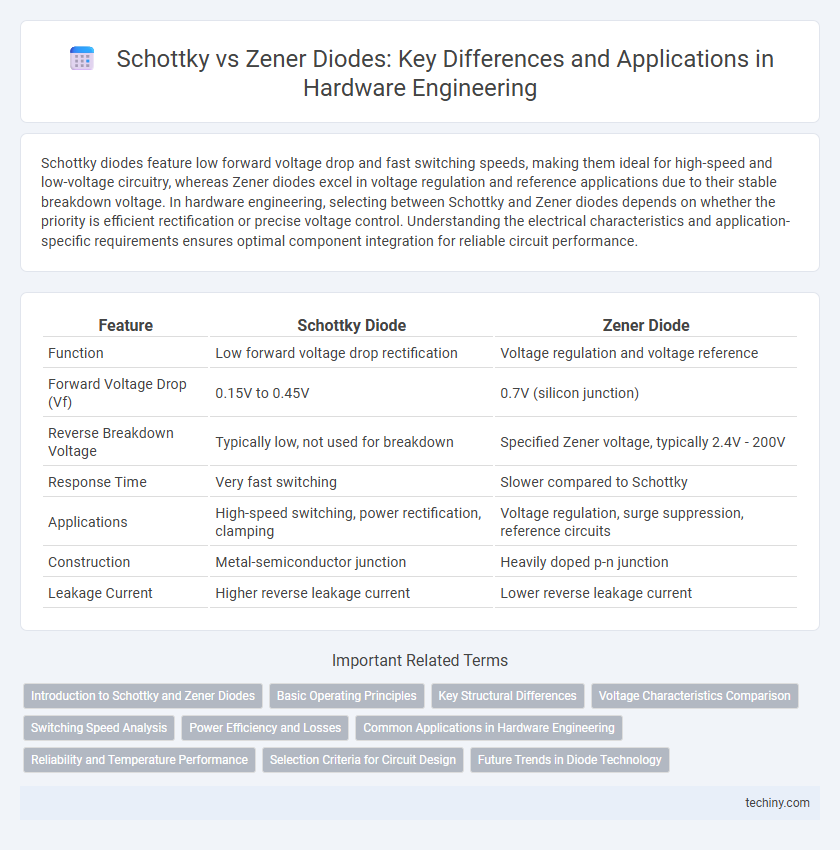Schottky diodes feature low forward voltage drop and fast switching speeds, making them ideal for high-speed and low-voltage circuitry, whereas Zener diodes excel in voltage regulation and reference applications due to their stable breakdown voltage. In hardware engineering, selecting between Schottky and Zener diodes depends on whether the priority is efficient rectification or precise voltage control. Understanding the electrical characteristics and application-specific requirements ensures optimal component integration for reliable circuit performance.
Table of Comparison
| Feature | Schottky Diode | Zener Diode |
|---|---|---|
| Function | Low forward voltage drop rectification | Voltage regulation and voltage reference |
| Forward Voltage Drop (Vf) | 0.15V to 0.45V | 0.7V (silicon junction) |
| Reverse Breakdown Voltage | Typically low, not used for breakdown | Specified Zener voltage, typically 2.4V - 200V |
| Response Time | Very fast switching | Slower compared to Schottky |
| Applications | High-speed switching, power rectification, clamping | Voltage regulation, surge suppression, reference circuits |
| Construction | Metal-semiconductor junction | Heavily doped p-n junction |
| Leakage Current | Higher reverse leakage current | Lower reverse leakage current |
Introduction to Schottky and Zener Diodes
Schottky diodes feature a metal-semiconductor junction, enabling fast switching and low forward voltage drop typically around 0.2 to 0.3 volts, ideal for high-speed and low-power applications. Zener diodes operate with a heavily doped p-n junction that facilitates voltage regulation by maintaining a stable breakdown voltage, commonly used in voltage reference and protection circuits. These distinct semiconductor structures define their roles in rectification, voltage clamping, and circuit stabilization within hardware engineering.
Basic Operating Principles
Schottky diodes operate using a metal-semiconductor junction, offering low forward voltage drop and fast switching speeds ideal for high-frequency applications. Zener diodes function by allowing current to reverse-bias and maintain a stable voltage through avalanche breakdown, making them essential for voltage regulation and reference circuits. The fundamental difference lies in Schottky diodes' conduction mechanism versus Zener diodes' controlled breakdown, impacting their use in power management and protection.
Key Structural Differences
Schottky diodes feature a metal-semiconductor junction that results in a low forward voltage drop and fast switching speed, whereas Zener diodes have a heavily doped p-n junction designed to exploit avalanche breakdown for voltage regulation. The Schottky's metal-semiconductor interface minimizes stored charge, enhancing efficiency in high-frequency applications, while the Zener's p-n junction enables stable voltage reference under reverse bias conditions. These structural differences dictate their distinct roles: Schottky diodes excel in rectification and clamping, and Zener diodes are optimized for voltage stabilization and protection circuits.
Voltage Characteristics Comparison
Schottky diodes exhibit lower forward voltage drops, typically around 0.2 to 0.3 volts, enabling faster switching and higher efficiency in low-voltage applications. Zener diodes maintain a stable reverse breakdown voltage, ranging from a few volts to hundreds of volts, making them ideal for voltage regulation and reference. The key voltage characteristic difference lies in Schottky's low forward voltage and Zener's precise reverse breakdown voltage clamp.
Switching Speed Analysis
Schottky diodes exhibit significantly faster switching speeds than Zener diodes due to their majority carrier conduction mechanism, which minimizes charge storage and reduces recovery time. Typical switching times for Schottky diodes range from picoseconds to nanoseconds, whereas Zener diodes, relying on avalanche breakdown, have slower response times in the microsecond range. This speed advantage makes Schottky diodes ideal for high-frequency rectification and fast switching applications in hardware engineering.
Power Efficiency and Losses
Schottky diodes exhibit lower forward voltage drop, typically around 0.2 to 0.3 volts, resulting in higher power efficiency and reduced conduction losses compared to Zener diodes. Zener diodes primarily serve voltage regulation with a higher voltage drop and significant power dissipation during breakdown, which increases overall power losses in circuits. Selecting Schottky diodes in power-sensitive applications minimizes energy loss and heat generation, enhancing system reliability and efficiency.
Common Applications in Hardware Engineering
Schottky diodes are commonly used in power rectification, voltage clamping, and RF applications due to their low forward voltage drop and fast switching speed. Zener diodes serve primarily as voltage regulators, reference elements, and protection devices by maintaining a stable breakdown voltage in circuit designs. Both diodes play crucial roles in hardware engineering for ensuring efficient power management and circuit stability in electronic systems.
Reliability and Temperature Performance
Schottky diodes exhibit superior switching speed and lower forward voltage drop, enhancing reliability in high-frequency applications, but they have lower reverse voltage tolerance and increased leakage currents at elevated temperatures. Zener diodes maintain stable voltage regulation over a wide temperature range, making them more reliable for voltage reference and protection roles under varying thermal conditions despite slower response times. Temperature performance of Schottky diodes is limited by their semiconductor junction properties, whereas Zener diodes benefit from avalanche breakdown mechanisms that provide consistent operation across harsh thermal environments.
Selection Criteria for Circuit Design
Selecting between Schottky and Zener diodes for circuit design hinges on factors like voltage regulation precision, switching speed, and leakage current. Schottky diodes exhibit low forward voltage drop (~0.2-0.3V) and fast switching, ideal for high-frequency rectification and clamping applications, while Zener diodes provide stable voltage regulation at specific breakdown voltages for reference or protection circuits. Designers choose Schottky diodes to enhance efficiency and reduce power loss, whereas Zener diodes are preferred for voltage stabilization and over-voltage protection in linear regulator circuits.
Future Trends in Diode Technology
Future trends in diode technology emphasize enhanced speed and energy efficiency, with Schottky diodes advancing in low forward voltage drop and high switching speeds, ideal for power management in next-generation electronics. Zener diodes are evolving with improved voltage regulation accuracy and integration in compact, smart circuits tailored for IoT and autonomous systems. Emerging materials like silicon carbide and gallium nitride are poised to revolutionize both Schottky and Zener diodes, pushing performance boundaries in high-temperature and high-frequency applications.
Schottky vs Zener Infographic

 techiny.com
techiny.com